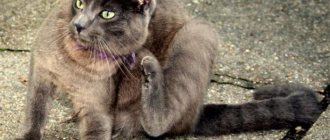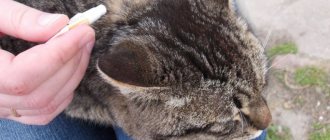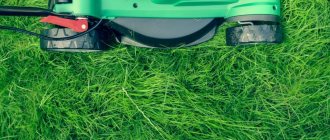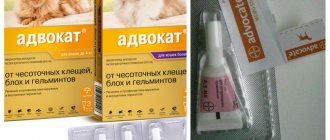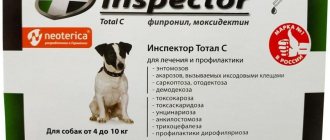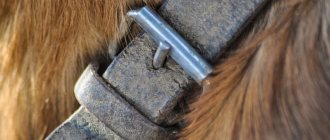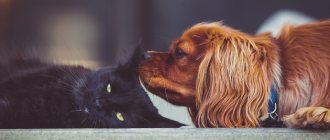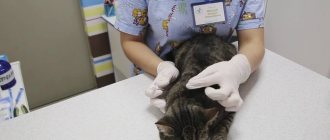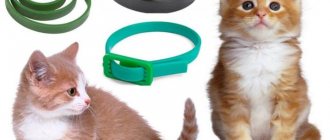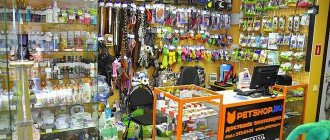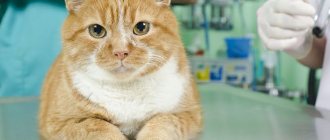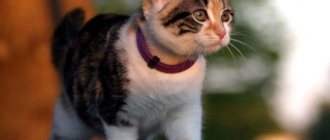Even a domestic cat that has never gone outside can become infected with fleas, ticks, and helminths. If a kitten is taken from the street, there is a high probability that it is infected with ecto- or endoparasites.
There are many veterinary remedies for parasites: drops, tablets, sprays. For opponents of medications, there are time-tested folk methods. What is the most effective treatment for fleas and worms?
What substances are used in flea treatments?
To combat insects, products based on organic or synthesized insecticides are used. The task of these substances is to destroy the parasite, which they successfully do by acting at the cellular level. Despite the fact that most insecticides are quite toxic, in the quantities in which they are applied to the skin of an animal, they are safe for pets.
The most common insecticides that act as active ingredients in preparations:
- Permethrin. An insecticide and acaricide belonging to the group of pyrethrins - natural toxins contained in the flowers of plants of the aster family. It is a neurotoxic poison, disrupts the ion permeability of sodium channels and inhibits the process of polarization of the membrane of nerve cells.
- Pyriproxyfen. Analogue of insect growth hormone. Blocks embryogenesis, metamorphosis and reproduction of sexually mature individuals. Under the influence of the drug, the larvae die, and the adults become sterile.
- Fipronil. Insecticide from the phenylpyrazoles group. In the insect's body, it binds to chloride channels and blocks GABA receptors. This leads to hyperexcitation, paralysis and death of the parasite.
Symptoms of fleas in a cat, why they are dangerous
Typical signs that a cat has fleas:
- Frequent itching. The animal itches regularly;
- Unstable sleep. The cat wakes up from any noise;
- Nervousness and lack of appetite. The pet actively marks its territory and refuses to eat its favorite food;
- Fast fatiguability. An animal with a large number of parasites on its fur is reluctant to engage in active play and tries to avoid household members.
Fleas on a cat's fur do not threaten the animal's life, but they provoke the development of many unpleasant problems. Your pet suffers from:
- Worries. The furry pet itches, trying to get rid of parasites, as a result of which wounds and scratches form on the skin;
- Deterioration in wool quality. Flea infestations lead to severe hair loss, sometimes to partial or complete baldness;
- Local problems. Due to scratching and partial hair loss, prerequisites for the development of allergic reactions are formed;
- Weakening of the immune system. The risks of infections, including those carried by fleas, increase.
What are combined preparations based on (for fleas, ticks, worms)?
Substances that destroy helminths:
- Ivermectin. Ingredient of antiparasitic drugs, effective against ecto- and endoparasites. It disrupts the transmission of nerve impulses, increasing GABAergic inhibition, which leads to paralysis and death. In helminths, it opens the chlorion channels of the muscle cells of the pharynx, which makes feeding impossible.
- Praziquantel. Anthelmintic. Increases the permeability of cell membranes to calcium, which leads to a sharp reduction in muscles, paralysis and death. Damages the worms' immune system, making them vulnerable to the host's digestive system.
- Moxidectin. Substance from the macrolide group. Effective against fleas, ticks and nematodes. Blocks GABA-dependent and glutamine-dependent ion channels, causing paralysis.
Compound
Good drops contain a new generation insecticidal substance. Fipronil and deltamethrin can be used. Auxiliary components enhance the penetrating ability of active substances, form consistency, and extend the duration of the drug.
The insecticide belongs to a low hazard class and, when used correctly, does not harm the animal. The owner should use rubber gloves when treating the pet, since if drops come into contact with the skin, an allergic reaction may develop.
Medicines for parasites
Drops on the withers
The use of drops against fleas and helminths is one of the most convenient ways to combat parasites. To cure an animal, it is enough to drop liquid between the shoulder blades once. Most of these products do not have undesirable effects; they can be used to treat kittens, and not only for treatment, but also for the prevention of infection.
Rating of the most effective drops on the withers against parasites:
- Inspector. A universal remedy for the destruction of ecto- and endoparasites. The active ingredients are fipronil and moxidectin. Since the composition contains rather strong substances, it is used only for treating animals weighing more than 4 kg. Drops are applied to the withers once, the drug is effective for 2 months. After application, the cat should not be washed for 4 days.
- Frontline. French drug of complex action based on fipronil. Can be used to treat kittens from two months of age. They can poison not only fleas, ixodid and ear ticks, but also helminths. After a single application it lasts for one and a half months. Side effects include a slight change in the color of the coat in the withers area. Frontline drops.
- Stronghold. Drops of complex action based on selamectin. With their help, flea dermatitis, otodectosis, demodicosis, and helminthiasis are treated. One application is enough to protect your pet from parasites for a month. Allowed to be used to treat cats from 7 weeks of age.
- Advocate. The drops are available in two versions: for adult cats and kittens. Effective against ectoparasites and nematodes. The composition includes the insecticide imidacloprid and the macrolide moxidectin. Can be used for preventive purposes from 10 weeks of age.
- IN-AP Complex. The active components of the drops are aversectin, fipronil, praziquantel. Drops are applied to the withers, the substance is gradually distributed throughout the coat and poisons fleas and ticks, and after absorption it destroys helminths.
- Helminthal. Drops based on praziquantel and moxidectin. Effective against nematodes, cestodias, entomoses, otodectosis. It can be used to prevent dirofilariasis, since the drug destroys dirofilaria larvae, but does not affect adult individuals.
Tablets for oral use
If the cat refuses to eat the medicine, it is crushed and mixed with its usual food. In addition, there is a special device - a tablet dispenser, with the help of which the tablet is squeezed onto the root of the tongue, and the pet, thanks to the swallowing reflex, swallows it.
The best tablets for removing parasites:
- Comfortis. Insecticide based on the natural toxin spinosad. The active substance is absorbed into the blood from the gastrointestinal tract and leads to excitation of insect motor neurons and their death. The dosage is calculated based on the cat's weight: 50 mg per 1 kg. In case of overdose, the following side effects are possible: weakness, drowsiness, lack of appetite, vomiting. To make the cat more willing to swallow the tablets, they are available in beef flavor.
- Capstar. Tablets with the synthetic active ingredient nitenpyram. They begin to act within 2–3 hours after entering the body. The course of treatment is only 1–2 days. It is allowed to give to kittens from 4 weeks of age.
- Prazimek-S. Complex antiparasitic agent based on praziquantel and abamectin. Removes nematodes, cestodes, trematodes, and also destroys insects. For the treatment of helminthiasis, give 1 tablet for every 2.5 kg, and for the treatment of entomosis - 2 tablets for the same weight. The course of treatment is twice with an interval of 7–10 days.
Spray and aerosol products
Sprays and aerosols are the most effective flea repellents. They are used when the disease is in an advanced stage. The spray is sprayed over the entire fur of the animal, except the muzzle. Most often, such medications contain highly toxic substances, so contact with mucous membranes, eyes and inside should be avoided.
The most effective sprays and aerosols:
- Harts. Spray containing insectoacaricides tetrachlorvinphos, S-methoprene. The drug is low-toxic and can be used to treat kittens from two months of age. Parasites are destroyed immediately after spraying.
- Leopard. Available in aerosol form (drops from the same line are also popular). Spray on the fur of a sick pet. Recommended for use outdoors or in a well-ventilated area, do not spray in a living room.
- Frontline. Safe product for adult cats and kittens, does not cause an allergic reaction. The effect is achieved in 20–30 minutes. After this time, it is recommended to comb out the dead insects from the cat.
Anti-flea collars
Cats that regularly go outside or spend the summer in the country are recommended to wear flea collars at all times. This accessory performs several functions at once. Firstly, it repels insects, and secondly, it shows that the cat has owners.
The collars are impregnated with insectoacaricidal substances. They can be used for both prevention and treatment of animals against insects.
The most popular flea collars:
- Harts. The effect of the accessory remains for 7 months after opening the package. It remains effective even after getting wet, so you can wash your cat without removing the collar. Allowed to be worn on kittens from 3 months. The manufacturer produces not only flea collars, but also reflective accessories.
- Bolfo. Another waterproof collar, but its lifespan is much shorter. It is active against fleas for 4 months, and against ticks for 3. During a long summer season, it is recommended to change the accessory at least once. The active substance is propoxur. Collars are available in different sizes and are selected depending on the weight of the animal.
- Doctor Zoo. The collar is made in Russia, the active ingredient is diazinon. The price is very low compared to other products - only about 100 rubles. However, the validity period is also short - 2 months.
The safest products for kittens, pregnant and lactating cats
Most products cannot be used to treat very small kittens, pregnant and lactating cats, and animals with weakened immunity after illness. What to do if just such a pet is infected?
Drugs that can be given to pregnant, lactating cats and small kittens:
- Fiprist spot-on. Insectoacaricidal drops based on fipronil. Although treatment of kittens under 8 weeks of age is prohibited, they can be used to treat pregnant and lactating cats. The drug does not have a teratogenic effect.
- Biodroplets "VETO Pure". The Dutch manufacturer (Beaphar) in the description of the drops states that they can be used without harm to treat pregnant, lactating cats, newborn kittens and animals with weakened immune systems. The drug does not contain toxic insecticides; it contains plant components, such as margosa. Thanks to this, the drops are not dangerous even if they get into the mouth. The validity period is 2-4 weeks, then you need to repeat the treatment.
- Milbemax. Deworming tablets that are allowed to be given to pregnant cats in the last third of pregnancy and lactating females 2-3 weeks after lambing. Active ingredients: praziquantel, milbemycin oxime. The tablet is given once, it is effective against nematodes and cestodes.
- Profender. Drops on the withers based on praziquantel and emodepside. Available in three versions: for kittens, for cats up to 5 kg and for cats from 5 kg. Allowed for use throughout the entire pregnancy period of cats. A single application is sufficient to get rid of worms.
Contraindications for use
Any medicine has its contraindications and flea drops are no exception. Most medications can only be used on pets older than 12 weeks. For a very small kitten, it is better to replace the droplets with a special shampoo, combing out fleas, or using traditional methods.
Almost every instruction contains restrictions for use by pregnant and lactating cats. Also, in order to avoid side effects, you should not use drops on weakened and exhausted cats. But the main contraindication is individual intolerance to the components.
Folk remedies
How to kill fleas and worms at home using traditional methods? If the owners do not want to resort to medications, then time-tested treatment methods will come to their aid:
- Hellebore water. An alcoholic infusion of hellebore is a plant that is a natural insecticide. The wool is sprayed with a spray bottle until the insects are completely destroyed. Dead parasites are combed out with a fine comb.
- Wormwood decoction. The specific smell of wormwood repels most insects - ticks, fleas, lice eaters. For the decoction, take dry wormwood, eucalyptus, tansy in equal proportions, pour boiling water over it and cook over low heat for 20 minutes. When the liquid has cooled, bathe the cat in it, making sure that the broth does not get on the face.
- Decoction of geranium and lavender leaves. It will help rid the animal of both insects and worms. 2 tbsp. l. wormwood and tansy are poured with 250 ml of boiling water. The cat is given 3 tbsp. l. infusion for 3 days.
- Garlic. The pungent garlic smell repels parasites. A few cloves of garlic are crushed and poured with 3 cups of boiling water. The liquid is infused for 12 hours and then dripped onto the animal’s withers. From there, the cat will not be able to lick off the poisonous infusion.
- Tar soap. This remedy is good because it not only destroys insects, but also promotes the healing of wounds, ulcers, and irritation after bites. Whisk the soap into a thick foam and wash the cat. The procedure should be repeated until the ectoparasites are completely eliminated.
- Pumpkin seeds. One of the most popular folk methods of getting rid of worms. 300 g of seeds are crushed to a paste, mixed with 50 ml of water and 15 g of honey. The resulting mixture is given to the cat, and after half an hour an enema is given. Another recipe with pumpkin seeds: 5 g of crushed pumpkin seeds are mixed with 5 g of pork fat. The cat is fed this mixture on an empty stomach for 5 days.
Side effects
Flea drops are not highly toxic, and if you notice that your pet has licked a little of the drug, there is no need to worry. Nothing serious will happen. For prevention, you can rinse your tongue and mouth with running water. However, if you did not follow the rules of application, and the cat licked large quantities of flea drops, the following side effects may occur:
- itching;
- allergic reaction;
- shiver;
- weakness;
- refusal of food;
- vomit;
- weight loss;
- temperature;
- lacrimation;
- severe salivation (sometimes until foam appears).
Your actions in case of poisoning must be immediate. For the first two days, you need to give your pet warm water and liquid food. Immediately after side effects appear, the animal should be bathed in warm water with shampoo, wiped dry and create comfortable conditions for rest. If drops get on the mucous membranes of the eyes or mouth during treatment, rinse the damaged area with boiled water.
In the event that symptoms of poisoning last more than two days, self-medication should be stopped and professional help should be sought.
How to treat bedding, carpets, furniture?
It is convenient to use sprays and aerosols to treat the room. Use a spray bottle to spray the cat's bed, corners of the room and all places where the cat could leave fleas. Bedding and clothes are thoroughly washed at the highest temperatures; if the fabric allows, they are boiled.
In a cat's house or box, you can put a sachet with aromatic herbs that repel insects: wormwood, geranium, lavender. If the cat was bathed in a decoction of wormwood or hellebore water, then you can wash the floors and walls with these liquids, and wash home rugs in them. Essential oils of geranium, eucalyptus, cedar, and lemon repel ectoparasites. You can spray the corners of rooms and furniture with them.
Ways of infecting cats with fleas
Fleas are common wingless blood-sucking parasites that are typical carriers of pathogens of various diseases.
The street is considered a common place for cats to become infected with fleas. Even careful monitoring of a pet during its walking cannot definitely exclude the penetration of insects into it.
A few parasites are enough for them to comfortably settle in the fur and epithelium of a pet. Once an infected cat is brought into the home, fleas begin to lay eggs and reproduce. In 24 hours, an individual produces up to 5 dozen eggs, which form into adult parasites in 2 weeks. Moreover, only a third of them are on furry animals, while the rest are crawling around the apartment.
In some cases, a pet can become infected without even going outside. Other ways fleas penetrate fur:
- Balcony. During a short walk on the balcony, your pet can quickly become infected;
- Entrance. If the entrance doors are leaky, fleas enter the apartment from the entrance;
- People's clothes and shoes. Insects can be brought in by family members or guests on outerwear or shoes.
Right choice
Drops and collar for cats
Using drops is very convenient. Processing one pet takes a maximum of 5 minutes. Side effects are rare. However, there are other anti-flea products with a similar mechanism of action.
Which is better, a collar or drops is a question that makes the owner think. The collar is also easy to use. Put it around your neck, secure it, cut off the excess part. The protection lasts for about 6 months. But the collar is not recommended for small kittens, as well as active cats, cats that climb trees or like to walk along the street. An accident may happen.
What to choose: shampoo or drops. Cats that don't like baths won't be happy with the shampoo. A lengthy procedure is required, whereas effective drops are applied in a few seconds.
Veterinarians' opinion
Igor Skopin (veterinarian), 43 years old, Simferopol
This medicine demonstrates high effectiveness, as confirmed by reviews from cat owners and my colleagues. However, it must be used taking into account the instructions of a veterinarian. In addition, the expert must also independently select the dosage regimen taking into account the body weight of the pet.
Vasilisa Shukshina (veterinarian), 27 years old, Ryazan
Most often, cats and kittens calmly tolerate the effects of this veterinary medication. Pet owners like the affordable cost of the medicine and its effectiveness.
Anatoly Boriskin (veterinarian), 38 years old, Crimea
It is advisable to use any anthelmintic drugs only in consultation with your doctor. Drops, compared to tablets and other oral forms, have minimal contraindications and rare adverse reactions, so this dosage form is more preferable in the treatment of helminthiasis and related problems.
All information posted on the site is provided in accordance with the User Agreement and is not a direct instruction to action. We strongly recommend that before using any product, you must obtain a face-to-face consultation at an accredited veterinary clinic.
